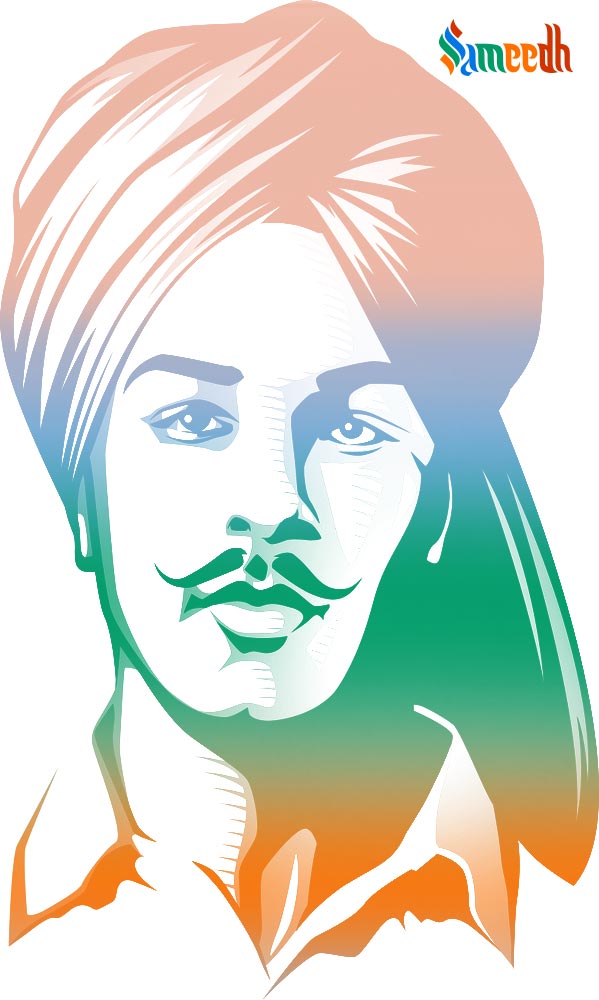Bhagat Singh was one of the greatest freedom fighters of the Independence movement of India. He was hanged by the British government at a young age of just 23 years.

Bhagat Singh was one of the greatest freedom fighters of the Independence movement of India. He joined several revolutionary groups and greatly contributed to the Indian National struggle. At the young age of just 23 years, he was hanged by the British government. The followers and admirers of Bhagat Singh honored him as a ‘Shaheed’, or martyr, after his execution on March 23, 1931.
Birth and childhood
Bhagat Singh was born on the 28th of September 1907, to parents Kishan Singh and Vidyavati in Banga, Lyallpur district of present Pakistan. His father Kishan Singh, his uncles Swaran Singh and Ajit Singh, were all imprisoned for protesting the 1906 Colonization Bill, at the time when Bhagat Singh was born. Sardar Ajit Singh, his uncle, founded the ‘Indian Patriots’ Association’ and supported the movement. Ajit Singh was compelled to leave for Iran since he was facing 22 cases. Young Bhagat Singh’s sense of patriotism was sparked by the fact that his family was a Gadar party supporter and due to the politically conscious environment at home.
Bhagat Singh attended his rural school until class five, at which point his father Kishan Singh transferred him to Lahore, where he was admitted at the Dayanand Anglo Vedic High School. His strong patriotic view was influenced by two events that occurred when he was a teenager: the 1919 Jallianwala Bagh massacre and the Nankana Sahib massacre in 1921, which saw unarmed Akali protesters slaughtered. His family supported Gandhi’s nonviolent movement for achieving Independence, and for a while, Bhagat Singh supported both the non-cooperation movement and the ‘Indian National Congress’.
After the Chauri Chaura Tragedy, Gandhi recommended that the movement against non-cooperation be abandoned. Bhagat Singh distanced himself from Gandhi’s movement of non-violence because he was unhappy with the choice. This is how his journey to popularity as the most strong supporter of a violent revolution against the British Rule.
The beginning of revolution
The Naujawan Bharat Sabha was established in March 1925, with Bhagat Singh, motivated by the nationalist movements in Europe. Bhagat Singh also became a member of the revolutionary group known as the ‘Hindustan Republican Association’, which later changed its name to the ‘Hindustan Socialist Republican Association’. The other members of this organisation were Rajguru, Sukhdev, Chandrashekhar Azad, Batukeshwar Dutt and many more. Bhagat Singh read voraciously while he was in college and became well-versed in nationalist movements in Europe. His political ideas developed as a result of being influenced by the literature of Lenin, Karl Marx, Frederick Engels, Bertrand Russell, Rabindranath Tagore, Alfred Tennyson, Umar Khaiyyam, Mark Twain, and several other writers and poets, he became more oriented towards a social ideology.
To protest the Simon Commission’s arrival, Lala Lajpat Rai headed an all-parties procession at the Lahore train station on October 30, 1928. To stop the protesters from going further, the police used a brutal lathi charge. Lala Lajpat Rai suffered serious injuries as a result of the brawl, and on November 17, 1928, he passed away. In retaliation, Bhagat Singh with his comrades planned the murder of Superintendent of Police James A. Scott, who was alleged to have ordered the use of lathi charge. But, the revolutionaries mistakenly killed J.P Saunders, who was the Assistant Superintendent of Police, instead of James Scott.
Arrest after the bomb blast at the Central Assembly hall
An ordinance was scheduled to be passed at an assembly, and the ‘Hindustan Socialist Republican Association’ had planned to explode a bomb in the Central Assembly. On April 8, 1929, Bhagat Singh and Batukeshwar Dutt hurled a bomb in the assembly hall while yelling ‘Inquilab Zindabad’! and flinging the pamphlets in the air, which explained their mission. Even though the bomb was hurled away from people with no intention of killing or hurting anyone, the blast still affected a number of representatives. Following the bomb blast, Bhagat Singh and Batukeshwar Dutt were immediately arrested.
The court ruled in support of a life sentence, citing the explosions’ malicious and unlawful motive. The bomb factories of HSRA in Lahore were raided by the police immediately after the sentence was delivered, and several well-known revolutionaries were detained.A total of 21 people were arrested, including Jatindranath Das, Rajguru and Sukhdev after Jai Gopal, Phanindranath Ghosh and Raj Vohra, turned approver for the government. In connection with the killing of J.P Saunders and the manufacturing of bombs, Bhagat Singh was charged again.
Judicial trial and Bhagat Singh’s Death
In July 1929, the trial commenced. In order to request fair treatment for ‘political prisoners’ who are treated like criminals, the young revolutionaries began a hunger strike in the prison in Lahore. Numerous politicians, including Jawaharlal Nehru, met them during their 116-day hunger strike, which they ended only after urging by their families and leaders of congress. As a result of a one-sided trial, Bhagat Singh, Rajguru and Sukhdev received death penalties. The verdict generated severe outrage, and several national leaders asked for the sentence to be reduced, but all in vain. Although their execution was scheduled for March 24 at the Lahore Jail, it apparently took place on March 23. The mortal remains of the young revolutionaries were secretly cremated after the execution.